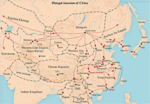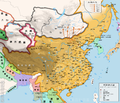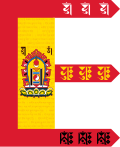Mongols in China, also known as Mongolian Chinese, are ethnic Mongols who live in China. They are one of the 56 ethnic groups recognized by the Chinese...
22 KB (2,282 words) - 20:06, 27 September 2024
allowing the Mongols to avenge the earlier death of a Mongol Khan, gain the riches of northern China and to establish the Mongols as a major power in the East-Asian...
74 KB (8,314 words) - 01:21, 24 September 2024
are referred to as Proto-Mongols. Broadly defined, the term includes the Mongols proper (also known as the Khalkha Mongols), Buryats, Oirats, the Kalmyks...
106 KB (11,334 words) - 02:25, 16 September 2024
Westholme Publishing) Genghis Khan and the Mongols The Mongol Empire Mongols The Mongols in World History The Mongol Empire for students Archived 27 November...
129 KB (15,075 words) - 23:38, 26 September 2024
Yuan dynasty (redirect from Mongol China)
reliability was introduced in China. The population was divided into the following classes: Mongols. The Mongols were called "Gao-chen"[Chinese script needed] (the...
121 KB (13,875 words) - 21:27, 25 September 2024
As the Mongol Empire began to fragment from 1260, conflict between the Mongols and Eastern European polities continued for centuries. Mongols continued...
30 KB (3,054 words) - 08:27, 21 September 2024
Inner Mongolia (redirect from Nei Mongol Autonomous Region, China)
registered as ethnic Mongols and continue to identify themselves as ethnic Mongols. The children of inter-ethnic Mongol-Chinese marriages also claim to...
108 KB (9,952 words) - 16:27, 25 September 2024
In modern times the Mongols are primarily Tibetan Buddhists, but in previous eras, especially during the time of the Mongol empire (13th–14th centuries)...
26 KB (3,472 words) - 09:06, 15 May 2024
and North China. The war, which started in 1211, lasted over 23 years and ended with the complete conquest of the Jin dynasty by the Mongols in 1234. The...
31 KB (3,948 words) - 13:45, 12 September 2024
movements, as the Mongols came into China from the north. The flight movements as the Mongols were fruitless in escaping from the Mongols, who soon brought...
19 KB (2,286 words) - 18:04, 4 September 2024
more diverse staff in the industry. In terms of international responses to China's policies towards Tibetans, Uyghurs and Mongols in the Tibet Autonomous...
127 KB (11,401 words) - 06:22, 24 September 2024
after the Mongols accepted the terms. The Mongols made heavy use of indigenous ethnic minority soldiers in southern China rather than Mongols. The Kingdom...
55 KB (6,646 words) - 21:16, 23 September 2024
used in 1231 by a Jin general named Wanyan Eke. He had lost the defense of Hezhong to the Mongols and fled on ships with 3,000 of his men. The Mongols pursued...
31 KB (4,157 words) - 01:08, 10 August 2024
Oirats (redirect from Oirat Mongols)
Eleuths (/ɪˈluːt/ or /ɪˈljuːθ/; Chinese: 厄魯特, Èlǔtè), are the westernmost group of the Mongols, whose ancestral home is in the Altai region of Siberia, Xinjiang...
46 KB (5,343 words) - 13:31, 9 September 2024
demand submission to the Mongols, but the Japanese ignored their demands. In 1265, a Goryeo citizen told Kublai that the Mongols should bring Japan to vassalage...
53 KB (6,577 words) - 05:15, 25 September 2024
simplified Chinese: 科尔沁部; traditional Chinese: 科爾沁部) are a subgroup of the Mongols that speak the Khorchin dialect of Mongolian and predominantly live in northeastern...
5 KB (510 words) - 06:32, 16 July 2023
However, the Oirat Mongols (the principal group of the Western Mongols) and Eastern Mongols remained hostile toward Ming China and each other. The Ming...
14 KB (1,543 words) - 05:28, 27 June 2024
resist the Mongols with aid from local clans until autumn 1255 when he was finally captured. As they had done during other invasions, the Mongols left the...
63 KB (7,700 words) - 01:03, 24 September 2024
designated an autonomous area for Mongols in China, only a little over five and a half per cent of Bortala's population is Mongol. "Bortala" comes from the Mongolian...
14 KB (564 words) - 17:42, 25 March 2024
The Sichuan Mongols (Chinese: 四川蒙古族) are officially counted among the Mongolian nationality in China. However, they are a distinct ethno-linguistic group...
2 KB (260 words) - 03:15, 29 January 2024
registered as ethnic Mongols and continue to identify themselves as ethnic Mongols. The children of inter-ethnic Mongol-Chinese marriages also claim to...
16 KB (1,881 words) - 09:00, 15 September 2024
Mongolia while fighting with the Mongols, and the Ming built a new Great Wall to prevent the Mongols' reconquest of China. In the 17th century, the Manchu-led...
7 KB (867 words) - 03:08, 14 July 2024
Mongols living within the Mongol Empire (1206–1368) maintained their own culture, not necessarily reflective of the majority population of the historical...
51 KB (7,936 words) - 04:38, 23 August 2024
Mongolian name (redirect from Mongol given name)
Some Mongols had Chinese names. For example, the Buddhist monk, Haiyun, bestowed the name Zhenjin (True-gold) to Khubilai and Chabi's eldest son. In the...
22 KB (2,654 words) - 02:16, 16 July 2024
History of Mongolia (redirect from Mongols before Chinggis Khan)
Mongolic-speaking Daurs in China are their direct descendants based on DNA evidence and other Khitans assimilated into the Mongols (Southern Mongols), Turkic peoples...
126 KB (16,838 words) - 14:15, 7 September 2024
Ilkhanate (redirect from Ilkhanid Mongols)
in 1243, the Mongols under Baiju occupied Anatolia, while the Seljuk Sultanate of Rûm and the Empire of Trebizond became vassals of the Mongols. In 1236...
47 KB (4,747 words) - 02:58, 26 September 2024
Chahars (redirect from Chahar (Mongols))
Tsahar; simplified Chinese: 察哈尔部; traditional Chinese: 察哈爾部) are a subgroup of Mongols that speak Chakhar Mongolian and predominantly live in southeastern Inner...
5 KB (575 words) - 23:23, 29 July 2024
marks, boxes, or other symbols instead of text in Mongolian script. The Secret History of the Mongols (Mongolian: ᠮᠣᠩᠭᠣᠯ ᠤᠨ ᠨᠢᠭᠤᠴᠠ ᠲᠣᠪᠴᠢᠶᠠᠨ [ˌmɔɴɢɜˈɮʲiːɴ...
22 KB (2,594 words) - 03:34, 11 September 2024
independence from Qing China. On 30 November 1911 the Mongols established the Temporary Government of Khalkha. On 29 December 1911 the Mongols declared their...
46 KB (5,249 words) - 04:10, 27 September 2024
ruling class of the Khalkha Mongols prior to the 20th century, but they were and still also regarded as Khalkha Mongols rather than belonging to a special...
17 KB (2,131 words) - 12:40, 26 September 2024






















